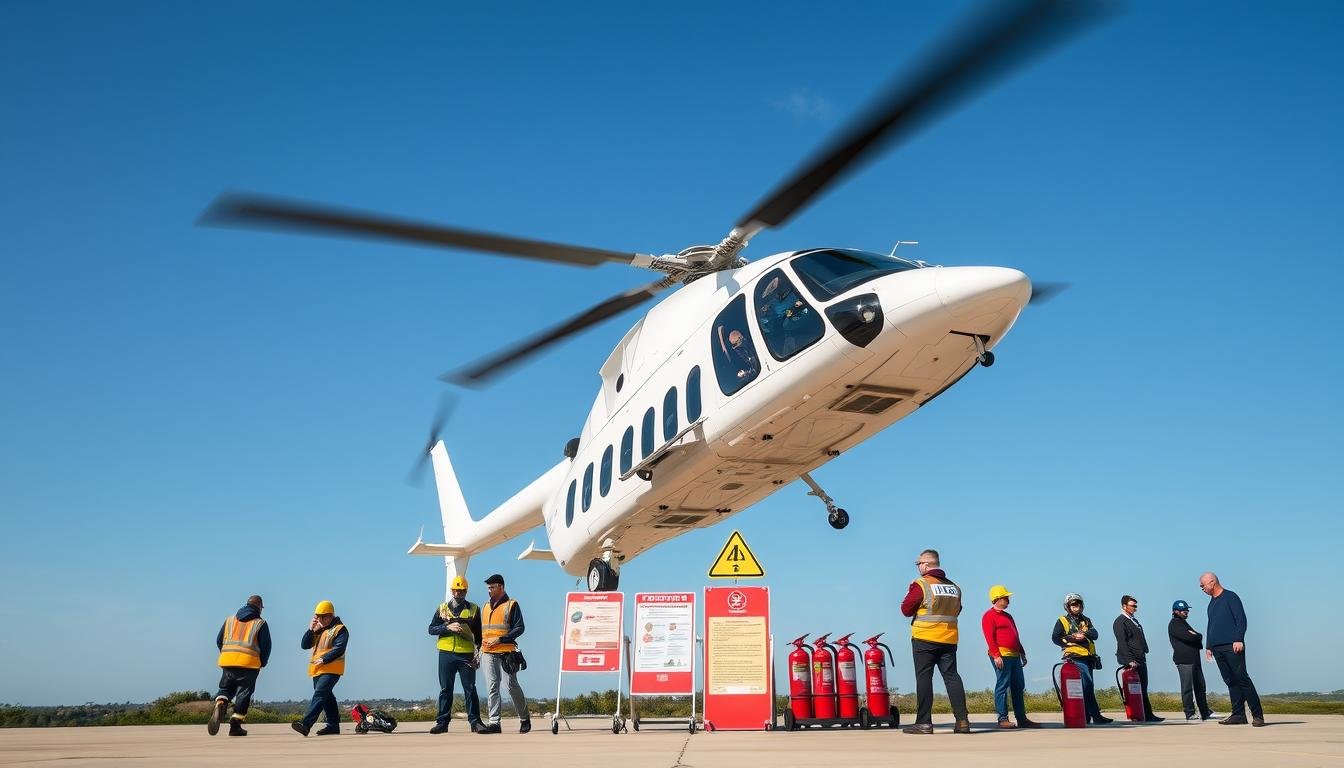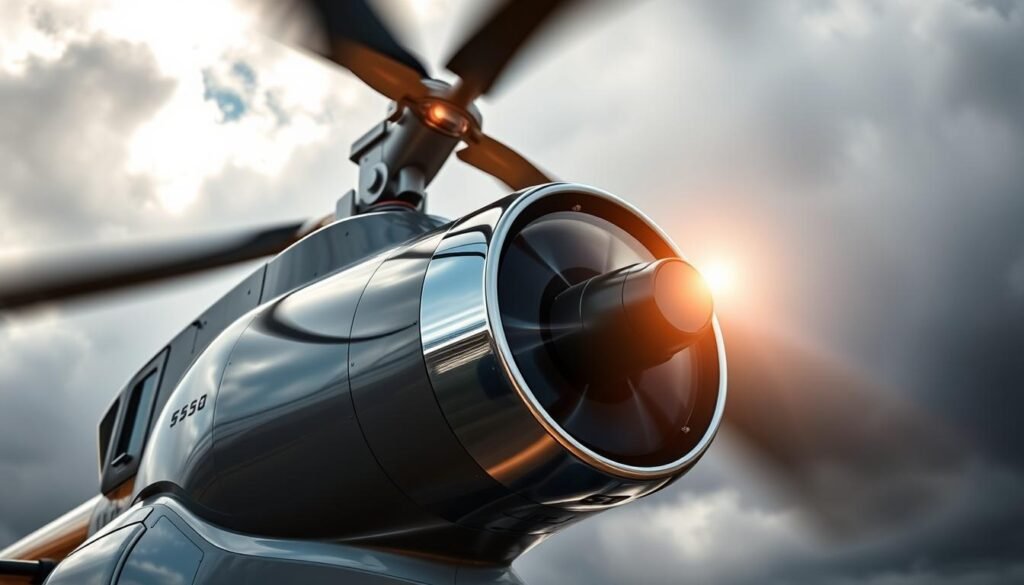65% of accidents trace back to routine lapses, not mechanical failure. That startling fact sets the stage for a clear, practical approach to the way crews and pilots manage each phase of a flight.
This introduction outlines a step-by-step path to build a safety-first mindset. It explains how disciplined habits reduce risk and make coordination visible on the ramp and in the cockpit.

The guide focuses on human factors, clear hand signals, and deliberate movement around the aircraft. It stresses non-negotiables—no running, phones stowed while moving, and never passing behind the tail rotor—backed by actionable checklists.
Readers will gain concise methods to brief mixed-experience teams, answer common questions on busy ramps and sloped sites, and adopt a repeatable framework that works every day.
Key Takeaways
- Discipline Prevents Complacency: Routine checks and habits cut risks fast.
- Clear Communication: Hand signals and briefings keep crew aligned.
- Human Factors Matter: Reduce distractions and standardize approaches.
- Non-Negotiables: Simple rules save lives and streamline operations.
- Repeatable Framework: Use the same procedures in every environment.
Helicopter Safety Tips: Culture, Human Factors, And Why They Still Matter
Crew culture and human factors shape every approach and exit around a rotorcraft. The fatal 2005 incident involving Lester Chambers shows how distraction and routine can erase hard-won protections.
Respecting The Rotor Disc: Lessons From A Veteran Instructor’s Tragedy
Lester Chambers, a 58-year-old flight instructor with 11,000 hours, was struck by a slowly turning main rotor after removing his helmet and walking away while texting. The blade was at roughly 20–30 rpm and still hazardous.
The event prompted Becker Helicopters to adopt formal Rotor Disc Protocols and the STAR method—Stop, Think, Assess, Rate. These require permission from the pilot, staying in the pilot’s line of sight, and treating every approach as controlled.
Building A Safety Culture The Crew And Passengers Live Every Flight
Leaders asked focused questions, not blame, and turned lessons into non-negotiables: no running, phones stowed while moving, securing loose items, and never walking behind the tail rotor.
| Protocol | Action | Who | Outcome |
|---|---|---|---|
| STAR | Stop, Think, Assess, Rate | Pilot & Crew | Consistent go/no-go decisions |
| Line-of-Sight Rule | Remain where pilot can see you | Passengers & Crew | Fewer approach errors |
| Slow-Rotor Awareness | Treat 20–30 rpm as hazardous | Crew | Reduced uncommanded contact risk |
| Movement Non-Negotiables | No phones; no running; secure gear | All | Lower ramp injuries to the head and body |
For broader context on risk and public concerns, see are helicopter rides safe.
How To Execute Rotor Disc Protocols And Approach/Depart Procedures Safely
Executing disciplined approach and exit routines keeps everyone visible and in control near an operating rotor disc. These steps make the pilot’s decisions clear and reduce errors during boarding or egress.

Apply The STAR Method: Stop, Think, Assess, Rate
Stop outside the rotor disc where the pilot can see you. Think about what you will do and confirm you have permission.
Assess group size, bags, sloped ground, loose clothing, blade rpm, wind, and any equipment that could snag. Rate the risk and ask the pilot for a go/no‑go decision.
Approaching With Blades Turning: Signals, Sightlines, And Safe Angles
Hold at the 10 o’clock or 2 o’clock position. Make eye contact and give a thumbs‑up. Only move after clear acknowledgment.
Walk in a controlled, low crouch, alternating your eyes between the path and the disc. Stay forward of the mast and keep your head low to maximize clearance.
Departing With Blades Turning: Pilot Coordination And Controlled Movement
Confirm intent with the pilot before unbuckling. Secure the door, step to the pilot’s window, signal, then exit at 10 or 2 o’clock while staying in sight.
Move directly away in a low posture and avoid carrying items above shoulder height so equipment does not catch or reduce clearance.
Ground And Environmental Risks: Slopes, Slow Rotors, And Loose Equipment
Treat slow‑rotor periods as high risk; blade sailing can lower tips near the ground. Avoid uphill approaches where blades sit lower.
Secure hats, straps, and phones until stationary. In groups, appoint a lead who coordinates each person one at a time to the pilot’s direction.
Non-Negotiables: No Running, No Phones, Never Behind The Tail Rotor
Never run near an aircraft, never move behind the tail rotor, and never assume clearance without explicit pilot acknowledgment. These simple rules stop the most severe incidents.
Passenger-Focused Safety: Managing Anxiety, Nausea, And In-Flight Comfort
A few simple preparations help passengers manage anxiety and motion discomfort during the flight. Clear steps before boarding improve comfort and reduce stressful situations.

Prepare Mind And Body: Physician Guidance And Breathing Support
Passengers who expect anxiety or motion sensitivity should consult their physician before travel and bring any prescribed inhalers or approved medications, following directions precisely.
Controlled breathing—slow nasal inhalations and long exhalations—reduces arousal. Grounding techniques help during climb and turns.
Use Distractions Wisely: Music, Conversation, And Photography
Use familiar music through an aircraft-approved headset and calm conversation to shift focus. Photography is fine only when the aircraft is secured and the crew permits it.
Keep equipment stowed while moving and ensure personal items do not become distractions to crew or pilot.
Combat Nausea: OTC Options, Citrus Snacks, And Head Stabilization
If motion sickness is a concern, discuss over-the-counter anti-nausea options with a clinician ahead of time.
Light citrus snacks can help settle the stomach. Stabilize the head against a headrest and close the eyes briefly to reduce sensory mismatch.
- Communicate Early: Tell the pilot about discomfort so they can adjust the profile or shorten segments.
- Pack Light: Secure loose equipment and arrive early to avoid rushed situations that raise stress.
- Review Briefings: Know seat belt operation and procedures so the overall experience feels controlled and familiar.
For further guidance on managing fear and preparation, see managing fear of flying and a practical passenger checklist at how to prepare for your first.
Conclusion
Consistent habits and visible roles turn procedures into predictable outcomes for every helicopter operation. The STAR method, rotor disc protocols, and clear pilot acknowledgments make routine actions reliable.
The crew reinforces hand signals, controlled movement, and lines of sight from approach to departure. Pilots model behavior, keep communications closed‑loop, and set aside time to brief risks so no one is left to guess.
The most valuable experience is repeatable and safe. Organizations should lock lessons into training, checklists, and ramp supervision. Leaders must keep asking focused questions to reduce variance and strengthen learning.
By committing together, pilot and crew preserve high margins and ensure every flight begins and ends under full control.
FAQ
What are the most important preflight checks a pilot must perform?
The pilot conducts a thorough inspection of the airframe, rotor system, fuel and oil levels, control linkages, and avionics before each flight. They verify weight-and-balance, confirm fuel type and quantity, and review weather briefings and NOTAMs. Crew members cross-check emergency equipment, passenger briefings, and communications procedures to ensure readiness.
How can crew build and maintain a strong safety culture?
Crew members model open communication, report hazards without fear, and participate in regular briefings and debriefings. The operator enforces standardized procedures, provides recurrent training, and rewards proactive risk reporting. Leadership sets expectations by attending safety meetings and following protocols consistently.
What procedure should passengers follow when approaching with rotors turning?
Passengers approach from the pilot’s eye side only after receiving a clear signal from crew. They keep low, enter within the pilot’s sightlines, secure loose clothing and gear, and never pass near the tail rotor. Crew supervises movement, offering hand assistance when terrain or conditions demand it.
What is the STAR method and how does it apply on the ground?
STAR stands for Stop, Think, Assess, Rate. People stop before action, think through hazards, assess options and environment, then rate the risk to choose a safe course. Pilots and ground crew use it for approach planning, refueling decisions, and adverse-weather operations.
What actions reduce risk when departing with blades turning?
The pilot confirms clearances, coordinates with the ground crew, and uses deliberate, steady power application. Crew members stand well clear, follow specific signals, and ensure doors and equipment are secure. The pilot scans for obstacles and selects a departure path that minimizes hover time near hazards.
How should crews manage slow-rotor or low-RPM situations on the ground?
They avoid walking near spinning blades, monitor rotor RPM closely, and maintain communication. If RPM decay occurs, the pilot follows the manufacturer’s procedure to recover or shut down safely. Ground personnel retreat to designated safe zones until blades are fully stopped.
What are the top non-negotiable rules for passengers around aircraft?
Passengers must never run, use phones while approaching, or pass behind the tail area. They should follow crew instructions, fasten seat belts, store loose items, and keep heads and limbs inside the cabin until given permission to exit.
How can nervous passengers prepare mentally and physically for a flight?
They consult a physician for medical advice when needed, practice controlled breathing, stay hydrated, and arrive rested. Crew briefings that explain procedures, expected sensations, and emergency exits help reduce anxiety. Small preflight walks and light snacks can improve comfort.
What strategies help prevent motion sickness during flights?
Taking over-the-counter antiemetics per label or physician advice, choosing bland, citrus-based snacks, and fixing the gaze on a stable horizon reduce nausea. Passengers keep heads stabilized with headrests, avoid heavy meals before flying, and use focused breathing or distraction techniques like music.
How should pilots and crew handle loose equipment and cargo hazards?
They secure all cargo to manufacturer limits, use nets or straps, and verify tie-downs during preflight. Crew inspects the cabin and external attachments after any stop. Loose items are stowed in approved compartments, and weight distribution is checked to maintain center-of-gravity limits.
What personal protective equipment should ground crew wear?
Ground crew wear hearing protection, high-visibility clothing, sturdy footwear, and helmets when required by operator policy. They avoid loose scarves or jackets and use gloves when handling fuel or equipment. Proper PPE reduces accident and hearing-loss risk.
When is it appropriate to refuse a flight or passenger request on safety grounds?
The pilot-in-command has final authority to refuse a flight if weather, mechanical issues, or weight-and-balance concerns compromise safety. Crew may deny passenger requests that conflict with secure stowage, exceed seat limitations, or jeopardize procedures. Safety overrides convenience every time.
What role do weather briefings play in flight safety decisions?
Weather briefings inform route selection, fuel planning, alternate fields, and go/no-go decisions. Pilots check winds, visibility, ceilings, icing potential, and turbulence forecasts. Updated briefings during delay or en route help adapt plans to changing conditions.
How often should pilots undergo recurrent training and checks?
Regulatory and operator standards require recurrent training at intervals that vary by certificate and operation type, commonly every six to twelve months. Checks include emergency procedures, instrument proficiency, and human factors training. Ongoing scenario-based practice keeps skills current.
What emergency equipment should be onboard for overwater flights?
Overwater flights carry life vests for each occupant, emergency locator transmitters (ELTs), and flotation gear when required. Crew checks that vests fit, know deployment procedures, and that survival kits include signaling devices, water, and basic first-aid supplies.
How can operators reduce runway and helipad surface risks like loose debris?
Regular inspections and swept surfaces reduce foreign object debris. Operators enforce vehicle and foot traffic controls, remove loose gravel and materials, and use perimeter fencing where practical. Briefing pilots about surface condition and slope helps mitigate hazards.
What are best practices for passenger briefings before takeoff?
Briefings cover seat belt use, door operation, life vest location, emergency exits, and brace positions. Crew demonstrates head and hand placement, communicates expected sensations, and confirms understanding. Clear, concise instructions help passengers respond correctly in an emergency.
How should pilots handle unexpected mechanical malfunctions in flight?
Pilots execute the applicable emergency checklist immediately, maintain aircraft control, communicate intentions to ATC, and prioritize a safe landing site. They brief passengers calmly, secure loose items, and, if necessary, prepare for autorotation or forced landing per training.
What steps minimize human-factor errors during multi-crew operations?
Teams use standard callouts, cross-check instruments, and confirm actions aloud. Briefing roles before critical phases, using sterile cockpit rules, and encouraging assertive challenge-response behavior reduce slips and lapses. Fatigue management and adequate rest are essential.
Related Articles
- How to Avoid Common Helicopter Pilot Errors: A Guide to Safe Flying
- The Role of Air Traffic Control in Helicopter Safety
- Helicopter Safety in Bad Weather: Tips for Flying in Adverse Conditions
- How to Safely Land a Helicopter in Challenging Conditions
- The Importance of Proper Helicopter Maintenance for Flight Safety
More from This Category
- Understanding Helicopter Weight and Balance: Why It’s Crucial for Safe Flying
- Emergency Procedures in Helicopter Flights: How to Handle In-Flight Incidents
- Helicopter Pre-Flight Inspections: What Pilots Must Check Before Takeoff
- How to Prepare for Your First Helicopter Ride: Safety Procedures for Passengers
- Top 10 Helicopter Safety Tips Every Pilot Should Know



